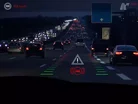University of Arizona is developing holographic heads up display for vehicles

The University of Arizona has been developing heads-up display technology to be used in road vehicles and planes.
The technology allows for drivers and pilots to receive and read information, such as driving directions or flight data, whilst still looking through the transparent glass of the front window.
Researchers at the university are currently working on incorporating holographics to the technology, which will allow the user a wider view.
Heads-up displays that are currently used are susceptible partly or wholly disappearing once the user averts there gaze too much.
“A heads-up display using our new technology installed in a car would allow a driver to see the displayed information even if he or she moved around or was shorter or taller than average,” stated the research team leader of the project at the University of Arizona, Pierre-Alexandre Blanche.
SEE ALSO:
“We are working with Honeywell to develop these displays for aircraft, but they could just as easily be used in cars.”
“Our approach requires no expensive equipment and no new materials need to be developed. Furthermore, the display can be completely integrated into a standard car windshield.”
The holographic technology used in the displays are smaller than the previously used components and easier to fabricate and manufacture.
“Increasing the size of either the eye box or the displayed image in a traditional heads-up display requires increasing the size of the projection optics, relay lenses and all the associated optics, which takes up too much space in the dashboard,” said Colton Bigler, doctoral student in Blanche’s laboratory.
“Instead of relying on conventional optics, we use holography to create a thin optical element that can be ultimately applied onto a windshield directly.”

